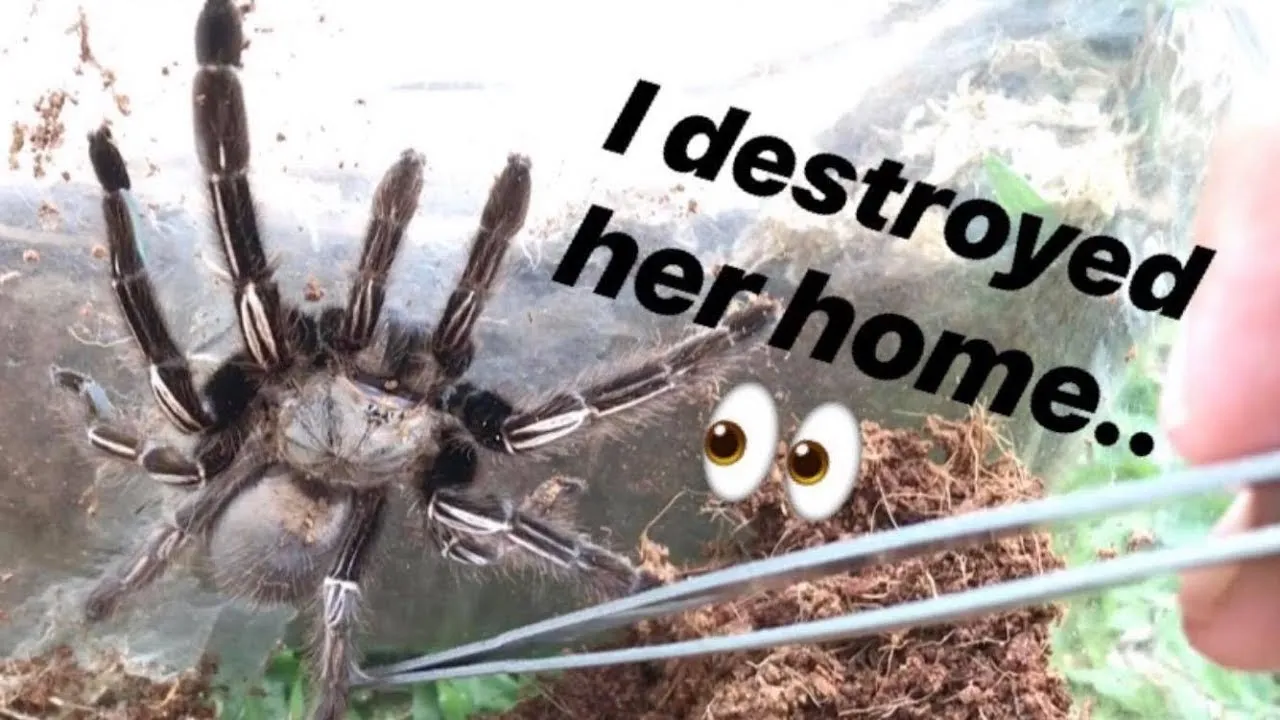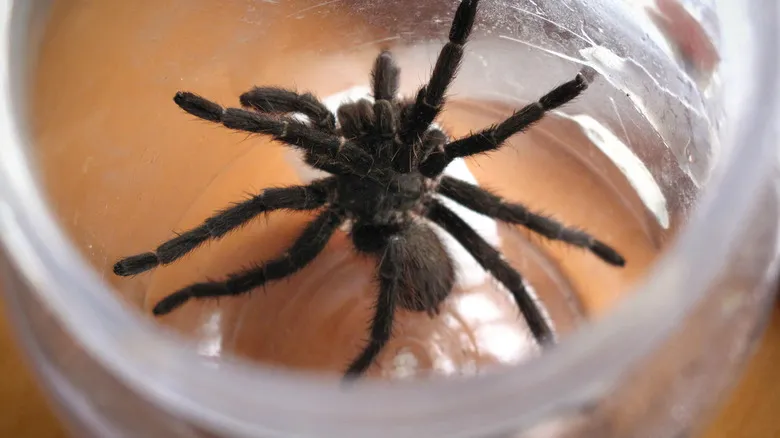What to Do When You See a Tarantula in Your House
Finding a tarantula in your house can be a startling experience. These large, hairy spiders can evoke a range of emotions, from fear to fascination. However, it’s crucial to react calmly and rationally. Understanding how to respond appropriately ensures your safety and the well-being of the tarantula. This guide will walk you through the steps to take, helping you manage the situation effectively and make informed decisions. Remember, tarantulas are generally not aggressive and prefer to avoid confrontation. Your calm demeanor is key to a successful resolution.
Stay Calm and Assess the Situation
The first and most important step is to remain calm. Panicking can lead to hasty decisions and increase the risk of a negative encounter. Take a moment to breathe and assess the situation. Where is the tarantula located? Is it in an open area or a hidden space? How big is it? Observe its behavior: Is it moving slowly or defensively? This initial assessment will help you determine the best course of action. Ensure that children and pets are kept away from the area to prevent any accidental interactions. It is advisable to let everyone to stay calm to reduce panic.
Identify the Tarantula

Identifying the type of tarantula can be helpful, although not always essential. While most tarantula species are not dangerous to humans, knowing the species can provide some peace of mind. If possible, take a picture or note any distinctive markings, colors, or size. This information can be useful if you need to contact a pest control expert or if the spider is captured for relocation. Online resources and field guides can help you identify common tarantula species in your region. However, prioritize your safety and avoid getting too close if you are unsure.
Determine the Tarantula’s Size and Species
Assessing the size and species is crucial. Size can impact how you approach removal – smaller tarantulas may be easier to manage. Species identification will also help you understand its temperament and potential risks. Note its leg span, body size, and coloration. Use online guides or pictures to help you in this process. This information can give you an idea on how to deal with the tarantula. Is it the type of tarantula that may be potentially aggressive or defensive? With this knowledge, you can prepare better.
Are Tarantulas Dangerous to Humans
Generally, tarantulas are not considered highly dangerous to humans. Their venom is typically mild, similar to a bee sting. However, bites can still cause discomfort and localized reactions. The primary risks associated with tarantulas come from their size and their defensive behaviors, such as the release of urticating hairs. These hairs can cause skin irritation and, if inhaled, respiratory problems. Understanding these potential hazards is key to mitigating risks and ensuring a safe encounter.
Tarantula Bites and Symptoms

Tarantula bites, while rare, can occur if the spider feels threatened. The symptoms of a tarantula bite usually include localized pain, redness, swelling, and itching at the bite site. More serious reactions are uncommon, but some individuals may experience allergic responses. It is crucial to clean the bite area with soap and water and monitor for any signs of infection or severe reactions, such as difficulty breathing or widespread swelling. If you experience significant symptoms, seek medical attention promptly. Remember to keep calm and seek medical advice for any concerns.
Allergic Reactions and Risks
Although rare, some people may be allergic to tarantula venom or the urticating hairs. Allergic reactions can range from mild skin irritation to more severe symptoms like difficulty breathing, hives, or swelling. If you experience any signs of an allergic reaction after encountering a tarantula, seek immediate medical attention. The risks are generally low, but it is essential to be aware of the possibility. Those with known allergies or sensitivities should exercise extra caution around tarantulas.
How to Safely Remove a Tarantula from Your House
Removing a tarantula from your house safely is a straightforward process. The goal is to capture and relocate the spider without causing harm to either you or the tarantula. Preparation and patience are key. Consider the welfare of the tarantula as you prepare to remove it from your house. With the right tools and a calm approach, you can successfully remove the tarantula from your home. Avoid use of pesticides or anything that will harm the tarantula.
Gather Necessary Equipment

Before you begin, gather the necessary equipment. You’ll need a clear container (like a large jar or plastic container), a piece of cardboard or a lid to cover the container, and a long object like a broom or ruler to gently guide the spider. Wear gloves to protect your hands. The best method is to use clear container so you can monitor the situation without putting yourself at risk. Preparation is key to ensure that the process is seamless and safe for both you and the tarantula. Gather the necessary tools so that you do not have to leave the process at any point.
The Capture and Release Process
Carefully place the container over the tarantula, ensuring it’s fully enclosed. Gently slide the cardboard or lid under the container to trap the spider inside. Once the tarantula is secured, carefully carry the container outside, away from your house. Find a safe location, such as a wooded area or a grassy field, and gently release the tarantula. Tip the container over and allow the spider to walk out on its own. Avoid shaking or dropping the container, as this could harm the tarantula. Make sure that the place that you are releasing the spider is safe for the tarantula, so that it can live peacefully.
Preventing Future Tarantula Encounters
Preventing tarantulas from entering your home is an ongoing effort. While it’s impossible to guarantee complete prevention, several steps can reduce the likelihood of encounters. Addressing potential entry points and maintaining a clean environment are key strategies. Prevention is better than cure. By being proactive, you can minimize the chances of finding these creatures in your home. By implementing these measures, you can reduce the likelihood of tarantulas entering your home and create a more comfortable living environment.
Seal Entry Points

Inspect your home for any potential entry points, such as cracks in the foundation, gaps around doors and windows, or openings around pipes and wires. Seal these openings with caulk, weather stripping, or other appropriate materials. Ensure that window screens are intact and properly fitted. Pay special attention to areas near the ground, as tarantulas often enter from the lower levels of a home. By taking the time to seal entry points, you can significantly reduce the chances of unwanted visitors.
Maintain a Clean Environment
Tarantulas are attracted to areas where they can find food, shelter, and moisture. Reduce the appeal of your home by maintaining a clean and tidy environment. Regularly clean and vacuum, paying attention to corners, under furniture, and other potential hiding spots. Store food in airtight containers to prevent attracting insects, which tarantulas may prey upon. Control moisture levels by repairing leaky pipes and ensuring proper ventilation. By keeping your house tidy, you make it less inviting for tarantulas and other pests.
What if You Can’t Remove the Tarantula
If you are unable or unwilling to remove the tarantula yourself, don’t hesitate to seek professional help. Contact a pest control service specializing in spider removal. They have the expertise and equipment to safely capture and relocate the tarantula. Trying to handle the situation yourself when you are uncomfortable or unsure could lead to a stressful or even dangerous situation. Their expertise will make sure that both you and the tarantula are safe. Professional help ensures a safe and effective resolution, giving you peace of mind.
Encountering a tarantula in your house can be a memorable experience. By remaining calm, understanding the risks, and following the steps outlined in this guide, you can react appropriately and safely. Remember, the goal is to ensure your safety and the well-being of the tarantula. Whether you choose to remove the spider yourself or call for professional help, a thoughtful and informed approach is key. By applying these tips and guidelines, you can handle this situation effectively and confidently, maintaining a safe and comfortable home environment.
